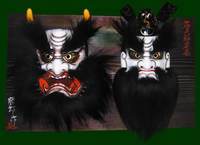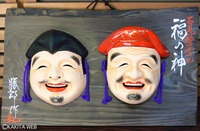

Total:131items
- Pottery & Porcelain (18)
- Lacquerware (4)
- Glasswork (2)
- Wood & Bamboo Work (19)
- Leather Work (1)
- Papermaking (13)
- Textile (20)
- Dyeing products (5)
- Masonry (1)
- Metal Work (11)
- Stationery (4)
- Livingware (3)
- Accessory (4)
- Toys & Entertainment (14)
- Interior (2)
- Other crafts (10)
- Osaka Shamisen (Japanese three-stringed guitar)
- Kyo-Hanga: Kyoto woodblock print
- Hyuga Kendo Armor
- Kanazawa-Haku: Kanazawa Gold Leaf
- Simotsuke-Suisha: Simotsuke Waterwheel
- Koshigaya-Katchu: Japanese traditional armor
- Ise netsuke : Ise miniature wooden sculpture
- Yuton: Lacquered Paper Mat
- Iwami Kagura Mask
- Oroku-gushi: Oroku-gushi Combs

 |
Main Production Site:Shimane |
 《Characteristics》
《Characteristics》Kagura is a Japanese traditional performing art and has developed into diverse forms in various regions of Japan. Iwami Kagura is one of it.
Iwami Kagura flourished in the Iwami region, the western half of Shimane prefecture, and used to be only performed by Shinto priests as a ritual dance. However, during the Meiji period (19-20 c), more and more local citizens began to perform Kagura, resulting in the formation of Kagura troupes in the Iwami region.
There are currently more than 400 Iwami Kagura troupes across the Iwami region and Hiroshima prefecture. Many of these troupes use Iwami Kagura masks (technique classification: Nagahama mask/ Ichiki mask) created from washi (Japanese paper) processed with strong kozo (paper mulberry). Although each kagura troupe makes its own original masks, it is rare to have so many Kagura troupes using washi masks. Washi masks are light and durable, making them highly suitable for the majestic and fast-paced dances of Iwami Kagura. They have been made in Hamada city for a long time.
[Designated as Shimane prefecture traditional craft]
Source: Kakita Katsuro Mask Workshop
Translation by Tham Wan Xin

| Materials | Clay, Washi (Japanese paper), glue with kakishibu (juice extracted from persimmon) |
|---|---|
| Crafting Processes | [1] Creating the mould
Create the mould of the mask using high quality clay [2] Drying [3] Making the mask Coat the mould with multiple layers of Sekishu washi (a traditional Japanese paper produced in the Iwami region) using the glue with kakishibu [4] Removing the mould Smash the mould using a wooden hammer [5] Applying kakishibu Apply kakishibu on the mask multiple times [6] Searing holes Sear holes for the eyes, nose and hair through the mask; searing is the best way because of the strength of the mask made of multiple layers of Sekishu washi. [7] Applying gofun (a fine white powder made from ground oyster shells) [8] Painting Paint the surface of the mask with colours [9] Attaching hair Use human hair, horse hair, yak hair etc. [10] Complete |
| History | Kagura flourished in the Iwami region and used to be only performed by Shinto priests as a ritual dance. However, during the Meiji period, more and more local citizens began to perform Kagura, resulting in the formation of Kagura troupes in the Iwami region. The washi mask is created by Japanese craftspeople who specialize in making Nagahama dolls (a traditional craft of Nagahama Town in Shimane prefecture). In recent years, besides the Kagura dance, the washi mask became popular as a housewarming gift or a souvenir. It is also presented as a gift to foreign countries (e.g. America, Korea, China, Bhutan, Indonesia), the Japanese imperial family and the Bhutan royal family. |
| Related URL | http://kakita.ai-fit.com/ |
◆Exhibition / Showcase
Kakita Katsuro Mask Workshop
Atsuta Town 636-60, Hamada City, Shimane Prefecture
Tel: 0855-27-1731 (Japanese only)
Closed on Wednesdays
◆Event Information
Assistance needed? For inquiries in English:
JTCO Contact Form
Your inquiries will be forwarded by JTCO in Japanese to the organization you wish to contact.
*Please write the name of craft you wish to ask about.



